 In late 2010, archaeologists excavating a Celtic cemetery near the Iron Age settlement of Heuneburg unearthed an intact grave. The rest of the cemetery had been extensively looted, so when the team found a gold brooch inside a wooden burial chamber, they realized they had a very special find on their hand. The timbers were preserved in soil waterlogged by a small river that flowed nearby, which may also be the reason the grave was never pillaged. Its water-filled interior and boggy soil made it difficult for would-be thieves to access and loot. With a cemetery full of graves on drier land, looters picked the path of least resistance.
In late 2010, archaeologists excavating a Celtic cemetery near the Iron Age settlement of Heuneburg unearthed an intact grave. The rest of the cemetery had been extensively looted, so when the team found a gold brooch inside a wooden burial chamber, they realized they had a very special find on their hand. The timbers were preserved in soil waterlogged by a small river that flowed nearby, which may also be the reason the grave was never pillaged. Its water-filled interior and boggy soil made it difficult for would-be thieves to access and loot. With a cemetery full of graves on drier land, looters picked the path of least resistance.
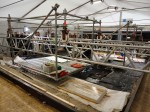 On December 28, 2010, the whole grave, encased in a 25-by-20 foot soil block weighing 80 tons, was raised and transported to the laboratory of the State Office for the Preservation of Monuments in Stuttgart. Archaeologists could now excavate the burial chamber in protected conditions, preserving the prehistoric timbers and any other organic remains, no matter how minute, and take all the time they needed for a thorough excavation. They discovered the contents of the tomb were extremely rich: more than 40 pieces of gold jewelry, more than 100 pieces of
On December 28, 2010, the whole grave, encased in a 25-by-20 foot soil block weighing 80 tons, was raised and transported to the laboratory of the State Office for the Preservation of Monuments in Stuttgart. Archaeologists could now excavate the burial chamber in protected conditions, preserving the prehistoric timbers and any other organic remains, no matter how minute, and take all the time they needed for a thorough excavation. They discovered the contents of the tomb were extremely rich: more than 40 pieces of gold jewelry, more than 100 pieces of 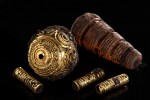 amber, plus jet, bronze and boar tusk jewelry and accessories, and an ornamental piece of armour for the head of a horse. This kind of armor was not produced in the Heuneburg area at this time. Part of it is consistent with work produced in northern Italy; some elements appear to be of southern Italian origin. It’s a testament to the variety and extent of the interregional trade in luxury goods during the Early Iron Age.
amber, plus jet, bronze and boar tusk jewelry and accessories, and an ornamental piece of armour for the head of a horse. This kind of armor was not produced in the Heuneburg area at this time. Part of it is consistent with work produced in northern Italy; some elements appear to be of southern Italian origin. It’s a testament to the variety and extent of the interregional trade in luxury goods during the Early Iron Age.
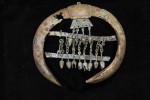 Most of the jewelry was adorned the skeletal remains of an adult woman. Her immense wealth and the wooden burial chamber, the only one of its kind every found, point to her being in the top echelon of Heuneburg society. The Celtic Princess of the Danube, as the press dubbed her, was between 30 and 40 years old when she died. The trunk of her skeleton was articulated and in place, while the skull was 10
Most of the jewelry was adorned the skeletal remains of an adult woman. Her immense wealth and the wooden burial chamber, the only one of its kind every found, point to her being in the top echelon of Heuneburg society. The Celtic Princess of the Danube, as the press dubbed her, was between 30 and 40 years old when she died. The trunk of her skeleton was articulated and in place, while the skull was 10 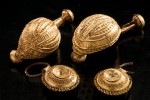 feet away and the mandible in a corner of the chamber. Also in the grave were the remains of young girl around two or three years old. She too wore jewelry and because it is very similar to that found on the adult woman, so similar it was probably created by the same goldsmith, archaeologists believe they were related, likely mother and daughter. According to Dirk Krausse of the State Office for Cultural Heritage, Baden-Wuerttemberg, the matching jewels are “very special. We have no parallels to compare from the other graves. They’re only known up to now from these two graves.”
feet away and the mandible in a corner of the chamber. Also in the grave were the remains of young girl around two or three years old. She too wore jewelry and because it is very similar to that found on the adult woman, so similar it was probably created by the same goldsmith, archaeologists believe they were related, likely mother and daughter. According to Dirk Krausse of the State Office for Cultural Heritage, Baden-Wuerttemberg, the matching jewels are “very special. We have no parallels to compare from the other graves. They’re only known up to now from these two graves.”
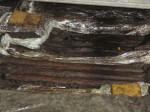 The style of the jewelry suggested a 7th century B.C. date for the grave. The preserved wooden timbers gave a more precise date: they were cut from a fir tree in 583 B.C. This was a prosperous time at Heuneburg. The Heuneburg hill fort dates to the Hallstatt period or Early Iron Age. The remains of wood and earthwork defensive fortifications from around 700 B.C. have been found, as have houses, burial mounds and expensive imported artifacts. A mud brick citadel wall on a massive limestone foundation 20 feet high was
The style of the jewelry suggested a 7th century B.C. date for the grave. The preserved wooden timbers gave a more precise date: they were cut from a fir tree in 583 B.C. This was a prosperous time at Heuneburg. The Heuneburg hill fort dates to the Hallstatt period or Early Iron Age. The remains of wood and earthwork defensive fortifications from around 700 B.C. have been found, as have houses, burial mounds and expensive imported artifacts. A mud brick citadel wall on a massive limestone foundation 20 feet high was  built around 600 B.C., a unique feature for Celtic settlements of this period. From 620 to 470 B.C., an estimated 10,000 people lived in Heuneburg which makes it by far the largest known prehistoric settlement north of the Alps as well as one of the oldest. More recent excavations at the foot of the hill have discovered a secondary housing site with homes grouped in walled compounds, an Iron Age suburban gated community, if you will. This is evidence in favor of classifying Heuneburg as not just a settlement, but an urban center. If so, it would make the hill fort the oldest urban site north of the Alps.
built around 600 B.C., a unique feature for Celtic settlements of this period. From 620 to 470 B.C., an estimated 10,000 people lived in Heuneburg which makes it by far the largest known prehistoric settlement north of the Alps as well as one of the oldest. More recent excavations at the foot of the hill have discovered a secondary housing site with homes grouped in walled compounds, an Iron Age suburban gated community, if you will. This is evidence in favor of classifying Heuneburg as not just a settlement, but an urban center. If so, it would make the hill fort the oldest urban site north of the Alps.
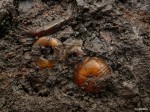 The remains of one other adult woman were found in the burial chamber. She had no jewelry, so researchers suspect she was a servant. At the moment it is not possible to determine whether and how the three individuals in the grave were related to each other.
The remains of one other adult woman were found in the burial chamber. She had no jewelry, so researchers suspect she was a servant. At the moment it is not possible to determine whether and how the three individuals in the grave were related to each other.
Biological remains have been retrieved from the woman’s skeleton, but there are not enough remains from the child to do a DNA test, Krausse said. Only the enamel from the child’s teeth now remains.
At the moment, DNA sequencing technology is not advanced enough to work on the fragments of biological remains from the child’s grave. “But in 10 years, 20 years, maybe we will have the technology,” Krausse said.
The research into the Heuneburg grave and its contents is slated to continue until 2018. The latest findings will be published in the journal Antiquity.
I always wonder about these “Celtic” finds. (i) Do we have any reason to suppose that those people spoke a Cletic language? (ii) This is presumably a quite different question: what is our evidence that they are one of the peoples called Keltoi by the Greeks?
I am most interested in seeing the chamfron for the horse. Any idea where there may be photos available?
This is a fascinating find in many ways. Much to be learned from it still. Thank you for continuing to follow this story. Much appreciated!
Dearieme, far from being an expert myself, there were almost certainly several ‘Celtic’ languages, which does not mean that they did not have linguistic features in common. Moreover, there is -apart from old boy Herodotus- actually quite a lot of Greek evidence.
Indeed, as far as I could tell, there is hardly any written ‘Keltic’ evidence, but some is using Greek letters – the ‘oi’ bit is of course a Greek plural, i.e. the ‘Keltic’ plural(s) are almost certainly different. Themselves, however, they would have referred to as individual peoples, as e.g. Ceasar is indicating in his ‘ De Bello Gallico’: There are, for instance, ‘Native Americans’, ‘Sioux’ and individual Sioux people(s), and ‘Indians’.
The ‘Keltoi’ live ‘where the Ister or the Danube has its source’, so the Heuneburg seems to be a candidate for being the ‘Pyrene’ that e.g. Herodotus is referring to, but not the only one, as there is e.g. the oppidum at Manching and others. Also, there were connections to each other and they had some form of basic ‘roads’ or ‘paths’. There are also ‘Proto-Celts’ with an even older tradition and features in common.
—————–
PS: “I don’t know where Alesia is! No one knows where Alesia is!”
The ‘bronze pendants mounted on boar tusks’ in the 4th photo look like bells that are intended to strike the horizontal plates when the piece is shaken.
“The ‘Keltoi’ live ‘where the Ister or the Danube has its source'”: Oppenheimer claims that the Greeks believed that the Danube rose in SW France.
:p I don’t know where Oppenheim lies, but take for granted that ‘France‘ was not even invented back then, not even by the Greeks.
In fact, it is a Roman invention, but they referred to them as ‘Transalpine Gauls’, in order to differ them from the ‘Cisalpine’ Italian ones.
Also, take for granted that the Greek goods brought to the banks of rivers in what is now France and the ones in what is now Germany found their way.
‘Greek’ contacts with ‘transalpine folk’ are –at least– 700 years older than any Roman ones. Viking contacts to ‘America’, just to put that in comparison, are only 500 years younger than any Spanish ones on record. Yet, their (hypothetic) descriptions are seemingly completely different. Nonetheless, the terms ‘Gallia’ and ‘Keltoi’ do not differ completely:
—————-
“The Galatians were part of the Celtic migration which invaded Macedon, led by Brennus. The ones who settled in Galatia [in what is now referred to as ‘Turkey’] came through Thrace under the leadership of Leotarios and Leonnorios in c. 278 BC. These Celts consisted of several tribes [from France as well as from Germany and possibly Czech Republic]. They spoke a Celtic language, the Galatian language, which is sparsely attested. In the 1st century AD, many of them were Christianized by Paul the Apostle’s missionary action. One of the Epistles of Paul the Apostle in the Bible is addressed to Galatian Christian communities [Epistle to the Galatians].”
—————-
:hattip: